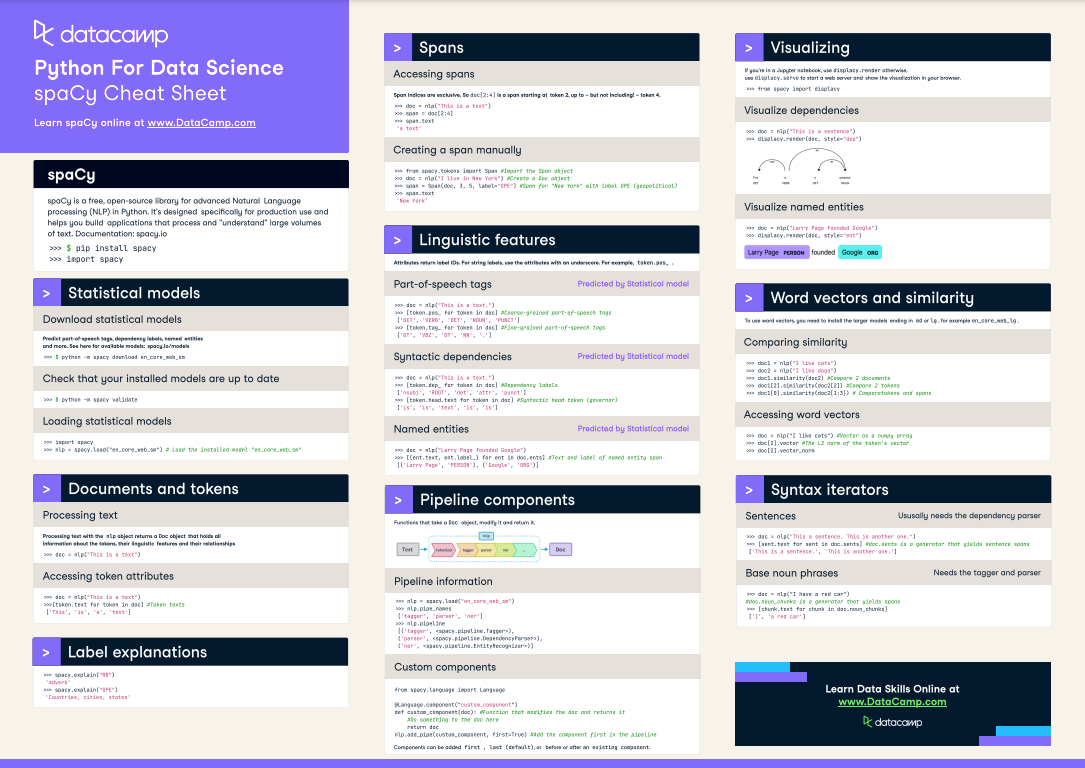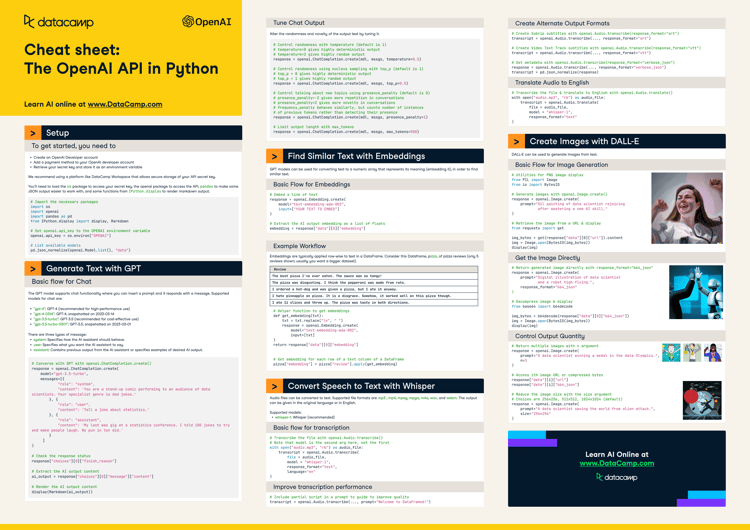About spaCy
spaCy is a free, open-source library for advanced Natural Language Processing (NLP) in Python. It's designed specifically for production use and helps you build applications that process and "understand" large volumes of text.
To learn more about spaCy, take my DataCamp course "Advanced NLP with spaCy". You can download the Cheat Sheet here!
Have this cheat sheet at your fingertips
Download PDFGetting started
$ pip install spacy
import spacy
Statistical models
Download statistical models
Predict part-of-speech tags, dependency labels, named entities and more. See here for available models.
$ python -m spacy download en_core_web_sm
Check that your installed models are up to date
$ python -m spacy validate
Loading statistical models
import spacy
# Load the installed model "en_core_web_sm"
nlp = spacy.load("en_core_web_sm")
Documents, tokens and spans
Processing text
Processing text with the nlp object returns a Doc object that holds all information about the tokens, their linguistic features and their relationships.
doc = nlp("This is a text")
Accessing token attributes
doc = nlp("This is a text")
# Token texts
[token.text for token in doc]
# ['This', 'is', 'a', 'text']
Spans
Accessing spans
Span indices are exclusive. So doc[2:4] is a span starting at token 2, up to – but not including! – token 4.
doc = nlp("This is a text")
span = doc[2:4]
span.text
# 'a text'
Creating a span manually
# Import the Span object
from spacy.tokens import Span
# Create a Doc object
doc = nlp("I live in New York")
# Span for "New York" with label GPE (geopolitical)
span = Span(doc, 3, 5, label="GPE")
span.text
# 'New York'
Linguistic features
Attributes return label IDs. For string labels, use the attributes with an underscore. For example, token.pos_.
Part-of-speech tags (predicted by statistical model)
doc = nlp("This is a text.")
# Coarse-grained part-of-speech tags
[token.pos_ for token in doc]
# ['DET', 'VERB', 'DET', 'NOUN', 'PUNCT']
# Fine-grained part-of-speech tags
[token.tag_ for token in doc]
# ['DT', 'VBZ', 'DT', 'NN', '.']
Syntactic dependencies (predicted by statistical model)
doc = nlp("This is a text.")
# Dependency labels
[token.dep_ for token in doc]
# ['nsubj', 'ROOT', 'det', 'attr', 'punct']
# Syntactic head token (governor)
[token.head.text for token in doc]
# ['is', 'is', 'text', 'is', 'is']
Named Entities (predicted by statistical model)
doc = nlp("Larry Page founded Google")
# Text and label of named entity span
[(ent.text, ent.label_) for ent in doc.ents]
# [('Larry Page', 'PERSON'), ('Google', 'ORG')]
Sentences (usually needs the dependency parser)
doc = nlp("This a sentence. This is another one.")
# doc.sents is a generator that yields sentence spans
[sent.text for sent in doc.sents]
# ['This is a sentence.', 'This is another one.']
Base noun phrases (needs the tagger and parser)
doc = nlp("I have a red car")
# doc.noun_chunks is a generator that yields spans
[chunk.text for chunk in doc.noun_chunks]
# ['I', 'a red car']
Label explanations
spacy.explain("RB")
# 'adverb'
spacy.explain("GPE")
# 'Countries, cities, states'
Visualizing
⚠️ If you're in a Jupyter notebook, use displacy.render. Otherwise, use displacy.serve to start a web server and show the visualization in your browser.
from spacy import displacy
Visualize dependencies
doc = nlp("This is a sentence")
displacy.render(doc, style="dep")

Visualize named entities
doc = nlp("Larry Page founded Google")
displacy.render(doc, style="ent")

Word vectors and similarity
⚠️ To use word vectors, you need to install the larger models ending in md or lg , for example en_core_web_lg.
Comparing similarity
doc1 = nlp("I like cats")
doc2 = nlp("I like dogs")
# Compare 2 documents
doc1.similarity(doc2)
# Compare 2 tokens
doc1[2].similarity(doc2[2])
# Compare tokens and spans
doc1[0].similarity(doc2[1:3])
Accessing word vectors
# Vector as a numpy array
doc = nlp("I like cats")
# The L2 norm of the token's vector
doc[2].vector
doc[2].vector_norm
Pipeline components
Functions that take a Doc object, modify it and return it.

Pipeline information
nlp = spacy.load("en_core_web_sm")
nlp.pipe_names
# ['tagger', 'parser', 'ner']
nlp.pipeline
# [('tagger', <spacy.pipeline.Tagger>),
# ('parser', <spacy.pipeline.DependencyParser>),
# ('ner', <spacy.pipeline.EntityRecognizer>)]
Custom components
from spacy.language import Language
@Language.component("custom_component")
def custom_component(doc): #Function that modifies the doc and returns it
#Do something to the doc here
return doc
nlp.add_pipe(custom_component, first=True) #Add the component first in the pipeline Components can be added first, last (default), or before or after an existing component.
Extension attributes
Custom attributes that are registered on the global Doc, Token and Span classes and become available as ._.
from spacy.tokens import Doc, Token, Span
doc = nlp("The sky over New York is blue")
Attribute extensions (with default value)
# Register custom attribute on Token class
Token.set_extension("is_color", default=False)
# Overwrite extension attribute with default value
doc[6]._.is_color = True
Property extensions (with getter & setter)
# Register custom attribute on Doc class
get_reversed = lambda doc: doc.text[::-1]
Doc.set_extension("reversed", getter=get_reversed)
# Compute value of extension attribute with getter
doc._.reversed
# 'eulb si kroY weN revo yks ehT'
Method extensions (callable method)
# Register custom attribute on Span class
has_label = lambda span, label: span.label_ == label
Span.set_extension("has_label", method=has_label)
# Compute value of extension attribute with method
doc[3:5].has_label("GPE")
# True
Rule-based matching
Using the Matcher
# Matcher is initialized with the shared vocab
from spacy.matcher import Matcher
# Each dict represents one token and its attributes
matcher = Matcher(nlp.vocab)
# Add with ID, optional callback and pattern(s)
pattern = [{"LOWER": "new"}, {"LOWER": "york"}]
matcher.add('CITIES', [pattern])
# Match by calling the matcher on a Doc object
doc = nlp("I live in New York")
matches = matcher(doc)
# Matches are (match_id, start, end) tuples
for match_id, start, end in matches:
# Get the matched span by slicing the Doc
span = doc[start:end]
print(span.text)
# 'New York'
Token patterns
# "love cats", "loving cats", "loved cats"
pattern1 = [{"LEMMA": "love"}, {"LOWER": "cats"}]
# "10 people", "twenty people"
pattern2 = [{"LIKE_NUM": True}, {"TEXT": "people"}]
# "book", "a cat", "the sea" (noun + optional article)
pattern3 = [{"POS": "DET", "OP": "?"}, {"POS": "NOUN"}]
Operators and quantifiers
Can be added to a token dict as the "OP" key.
| OP | Description |
|---|---|
! |
Negate pattern and match exactly 0 times. |
? |
Make pattern optional and match 0 or 1 times. |
+ |
Require pattern to match 1 or more times. |
* |
Allow pattern to match 0 or more times. |
spaCy Glossary
| Name | Description |
|---|---|
| Tokenization | Segmenting text into words, punctuation etc. |
| Lemmatization | Assigning the base forms of words, for example: "was" → "be" or "rats" → "rat". |
| Sentence Boundary Detection | Finding and segmenting individual sentences. |
| Part-of-speech (POS) Tagging | Assigning word types to tokens like verb or noun. |
| Dependency Parsing | Assigning syntactic dependency labels, describing the relations between individual tokens, like subject or object. |
| Named Entity Recognition (NER) | Labeling named "real-world" objects, like persons, companies or locations. |
| Text Classification | Assigning categories or labels to a whole document, or parts of a document. |
| Statistical model | Process for making predictions based on examples. |
| Training | Updating a statistical model with new examples. |




